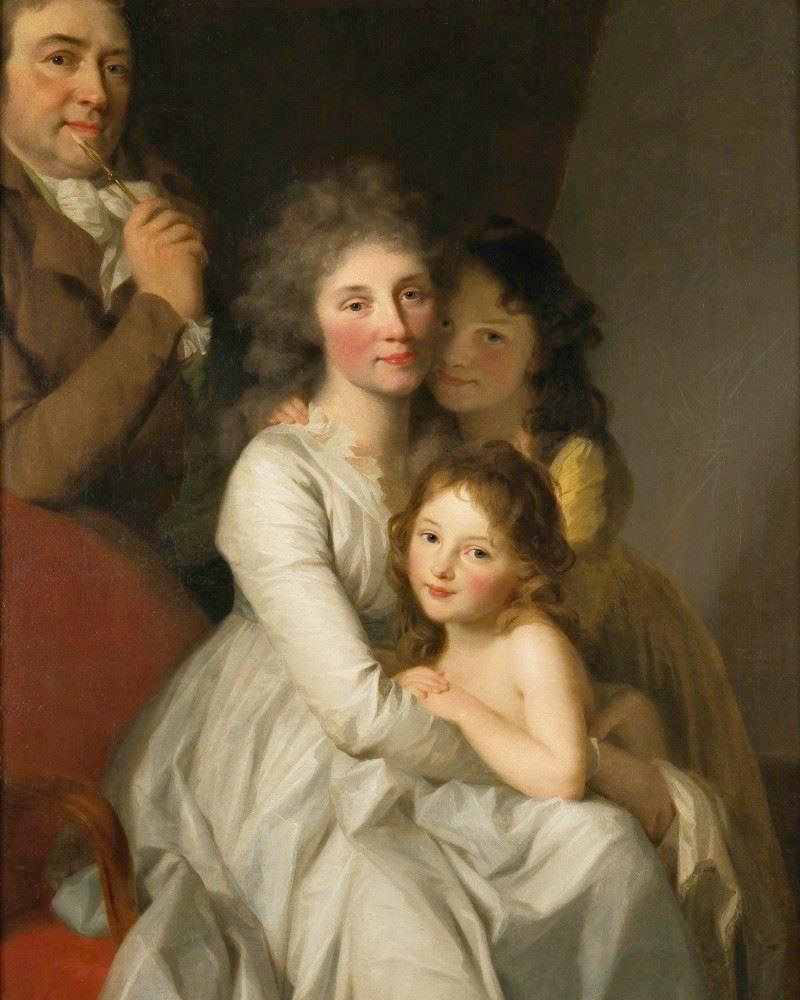
Artists Illustrating Boys' Fashions: The Tischbeins (Germany/Italy, 19th Century)

Figure 1.-- This is a self portrait by Johann Friedrich August Tischbein (1750-1812) with his family. It was painted in 1796. This was the year he moved to Berlin and set up an independent studio. The family entry into art was through set painting. His father, Johann Valentin Tischbein, was a set painter and his introduction to art was in his father's studio.
|
|
The Tischbeins family originated in Hesse, a state in central Germany. American are familiar with it as King Gerorgean contracted for Hessian mercuinaries to fight in the American Revolution. At the same time, the Tischbein family was becoming one of the most important family of craftsmen and artists in central Europe (18th century). August Anton Tischbein was born in Rostock, MeckIenburg (1805). Wilhelm Tischbein, the painter and antiquarian who notably accompanied Goethe on his trip to Italy was his uncle. August Anton like many of the Tischbeins travelled throughout Italy because of their interest in art. He was, however, the only Tischbein to open a studio in Italy. He lived in Trieste which at the time was part of the Austrian Empire (1838-67). Johann Jacob Tischbein painted landscapes and animals. His son August Albrecht Christian Tischbein was a portraitist and genre painter. Grandson August Anton worked in his father's studio also bcame an rtist. He entered the Berlin Art Academy at age 19 years. He then entered the Dresden Academy (1826). He made his first trip to Rome to study master works (1829). He made another trip to study master works and broaden his horizons, this time to the Netherlands, England, the cities on the Rhine, and Switzerland (1832). He ended up in Munich to continued his studies. Munich gave him access to the Alps and he made many trios to the Bavarian Mountains, the Tyrol, and northern Italy. He painted many landscape and genre scenes set in the Alps. He traveled to Rome again (1837). He subsequently taveled throughout northern and southern Italy. He finally settled in northern Italy. He married in Venice Venice and settled in Trieste. '
Johann Friedrich August Tischbein (1750-1812)
Johann received his first art instruction from his father, the set painter Johann Valentin Tischbein. He then went to Kassel to work in the studios of his uncle, Johann Heinrich Tischbein (1768). After workin there for 4 years, he traveled through France (1772). He ended up in Pris where he studied with Johann Georg Wille. And setting a family tradition, he toiured Italy. This was common bcause so many masterworks can be seen there. He spent time in Naples and Rome. He met and worked with Jacques-Louis David in Rome. He returned to Germany (1780). At his time he was appointed court painter to Friedrich Karl August, Prince of Waldeck and Pyrmont in Bad Arolsen. He was later named "Council and Cabinet Painter". He made three trips to the Netherlands to study the Dutch masters (1780s). This was on the behalf of his patron. Art critics believe that his skills benefitted. Leopold III, Duke of Anhalt-Dessau bcame his paron (1795). The art world was chnging, in part because of the French Revolution nd economic change. Western art for centuries was based primarily on aristocratic or church patronage. By the turn-of the 19th century, artists could increasingly become independent and obtain lucrative private commissions. Johann Friedrich obly a year lter went to Brlin to set up an independent portrait studio (1796). He found even more success in Dresden (1799). He was appointed to replace Adam Friedrich Oeser as Director of the Academy of Visual Arts in Leipzig (1800). He traveled to Saint Petersburg, Russia to settle the estate of his brother, the architect and set designer, Ludwig Philipp Tischbein (1744-1806). He remained there for three years to finish several lucrative commissions from the Russian aristocracy. His children, Caroline (1783–1843) and son Carl Wilhelm (1797-1855) also became recohnized artists.
Johann Jacob Tischbein
Johann Jacob Tischbein painted landscapes and animals.
August Albrecht Christian Tischbein
August Albrecht Christian Tischbein, Johann Jacob's son, was a portraitist and genre painter.
Wilhelm Tischbein
Wilhelm Tischbein, the painter and antiquarian who notably accompanied Goethe on his trip to Italy was his August Anton's uncle.
August Anton Tischbein was born in Rostock, MeckIenburg (1805). August Anton was August Albrecht's son. He worked in his father's studio and also bcame an artist. He entered the Berlin Art Academy at age 19 years. He then entered the Dresden Academy (1826). He made his first trip to Rome to study master works (1829). He made another trip to study master works and broaden his horizons, this time to the Netherlands, England, the cities on the Rhine, and Switzerland (1832). He like many of the Tischbeins travelled throughout Italy because of their interest in art. He was, however, the only Tischbein to open a studio in Italy. He lived in Trieste which at the time was part of the Austrian Empire (1838-67). He ended up in Munich to continued his studies. Munich gave him access to the Alps and he made many trips to the Bavarian Mountains, the Tyrol, and northern Italy. He painted many landscape and genre scenes set in the Alps. Thus we see German, Austrian, and Italian scenes. He traveled to Rome again (1837). He subsequently taveled throughout northern and southern Italy. He finally settled in northern Italy. He married in Venice Venice and settled in Trieste.
HBC

Navigate the Boys' Historical Clothing Artists pages:
[Return to Main German artist page]
[Return to Main Italian artist page]
[Return to Main Artists S-Z page]
[Chronology]
[Countries]
[Individuals]
[Styles]
Navigate the Boys' Historical Clothing Web Site:
[Introduction]
[Activities]
[Biographies]
[Chronology]
[Clothing styles]
[Countries]
[Bibliographies]
[Contributions]
[FAQs]
[Glossaries]
[Images]
[Links]
[Registration]
[Tools]
[Boys' Clothing Home]
Created: 9:16 AM 7/23/2018
Last updated: 9:17 AM 7/23/2018



